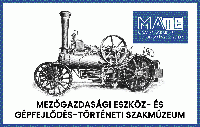SUMMARY
|
Agricultural Steam Engines |
After the simple power machines operated by natural - wind, water - power and muscular force the application of energy in fuels resulted in a revolutio-nal change. The progression started with the steam engine utilization of the energy in hard coal and solid fuels.
In the agricultural production the era of steam presented itself later than in other branches as industry and transport but it caused a revolutional progress and change.
The steam engine made for agriculture being a traction engine started from the Clayton-Shuttleworth firm, Lincoln in 1845 to conquer the world. There were quite earlier trials to develop and build engines. Already in the 1st century B. C. Heron of Alexandria a Greek mathematician and physicist described the principles of automatons operated partially by steam power. Six hundred years later in 1629 Giovanni Branca an Italian scientist designed a steam turbine to drive blade-wheel. After it Denis Papin a French physicist described an atmospheric steam engine operating with piston and cylinder (1690). A few years later an English technician Tom Savery patented a steam driven lift without piston (1698).
The reciprocating level, atmospheric pressure and piston steam engine was constructed by an English mine engineer Thomas Newcomen to drive mine pumps (1711).
The twin-cylinder reciprocating steam engine built by Ivan Ivanovits Polzunov russian specialist in 1766 is worth to mention. After this preliminaries the very steam-engine took shape in 1769 when JAMES WATT patented his direct driven low pressure engine. Still in that year a three-wheel steam vehicle of Nicolas-Joseph Cugnot a French military engineer occured in the streets of Paris. The aim of that construction was to carry guns.
In 1775 the Boulton-Watt firm the first steam-engine factory of the world was established in England.
In 1781 an English constructor Jonathan Hornblower patented a compound steam-engine manufacturing.
In 1784 JAMES WATT patented his rotating, double operating, low pressure steam-engine supplied with flyer.
In 1801 Richard Trevithick English technician brought into being a fore-goer of the locomotive a the steam vehicle which was operated already by high pressure steam engine.
In 1807 the American Richard Fulton built the first operating blade-wheel steamer. The first trial to construct agricultural steam-engine was done by Richard Trevithick who presented his machine in 1811. Later in 1841 Alexander Dean appeared with a vertical boiler steam-engine mounted on wheels. After these preliminaries the large scale steam locomobile manufacture started at the firm Clayton-Shuttleworth, Lincoln in 1845. Soon, more and more trials and efforts started to mechanize ploughing resulted in direct and indirect ploughing processes.
In 1837 Janes Usker constructed a steam digger-plough followed by more other trials. To the middle of the 19th century the unified steam ploughing system was formed in England due to John Fowler and his locomobile. That one engine system was followed by the two engine system within a decade. The two Fowler locomobile as power sources pulled the balance plough by turns.
The agricultural steam-engines reached their peak progress by the self-moving ploughing machines.
Usage of the agricultural steam engines in Hungary remained up to the middle of the 20th century, but it is the last two decade of the 19th century and the first three decade of 20th century what was their golden age.
2011 © Minden jog fenntartva!
info@gepmuzeum.szie.hu



